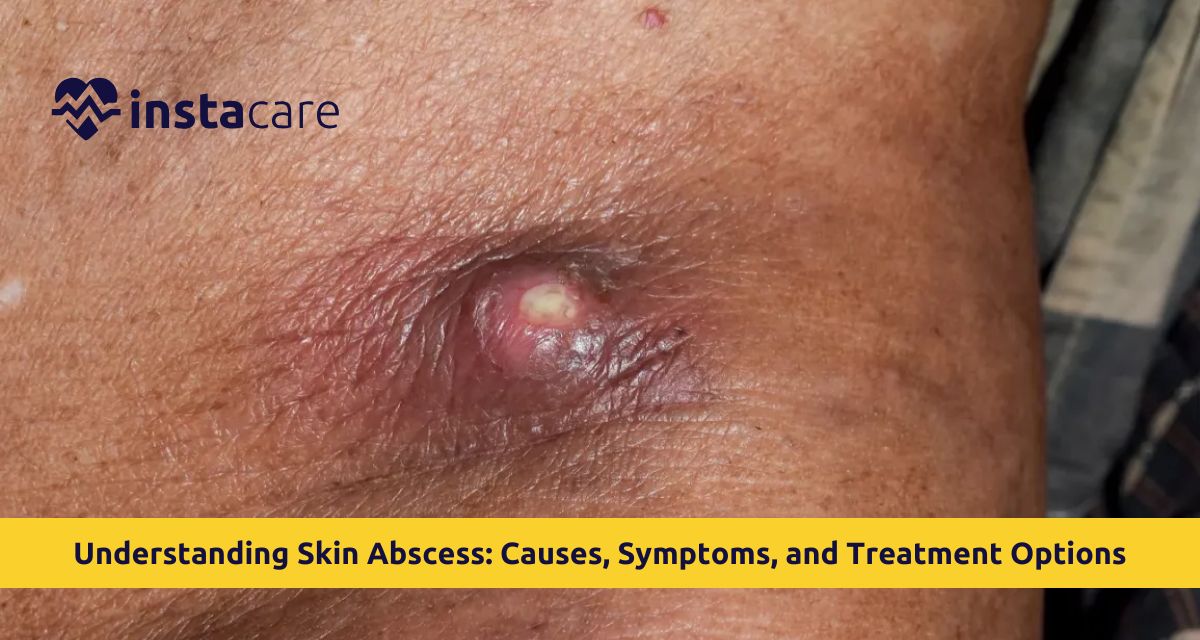Skin abscess develops as a localized skin infection which appears as a painful swollen lump filled with pus. The bacterial entry leads to inflammation and fluid accumulation which forms an abscess at the impacted skin break. Small abscesses will heal alone but physicians should treat patients with large or extensive abscesses. A person needs to execute appropriate care and cleaning to both treat existing abscesses and stop them from recurring.
What Is a Skin Abscess?
A skin abscess develops when bacteria such as Staphylococcus aureus leads to infection which creates an infected pocket of pus. The infection fight sends
white blood cells to the affected area which results in the formation of a tissue-bacteria-dead cell mass that we call an abscess. An abscessed skin area becomes red and swollen while feeling warm to the touch.
When an abscess emerges it can mimic a pimple along with other indicators of being hard and red. The abscess will get soft and be head-like, i.e., ready to burst. The area can be painful and even have fever or chills attached to it if the area is large.
Although they are located virtually anywhere, armpit, groin, buttock, and friction site area is most likely. The understanding idea of why they happen and in how, curing and safety becomes easy.
Various Reasons for Skin Abscess
Skin abscess happens when the bacteria inside them rupture the skin. Some common causes include:
- Bacterial penetration through wounds: Cuts, surgical wounds, scrapes, or insect bites can be an entry point to bacteria such as Staphylococcus aureus into the skin.
- Poor personal hygiene: Dirty environment causes more deposition of bacteria and inflammation of the skin.
- Obstruction of oil or sweat glands: These can be infected to form abscesses.
- Ingrown or infected hair: Infected or inflamed hair follicles can form boils and abscesses.
- Compromised immune status: Diabetes, HIV, or immunosuppression lowers the body's resistance to infection.
- Repetitive pressure or friction: Tight clothing or repetitive friction on the skin causes irritation of the immune response that can become an abscess.
- Skin diseases: Chronic diseases like eczema or acne create tissue weakness in which the bacteria can infect.
Early identification of these predisposing factors will prevent abscess development, especially in high-risk individuals.
Some of the Symptoms of Skin Abscess
Early detection of a skin abscess allows for proper and timely treatment. Signs and symptoms noted are:
- Red, swollen bump: painful, difficult to touch bump which can be palpated
- Heat: Warm sensation towards the area of the bump.
- Discharge or pus: The developing stage abscess becomes white or yellowish spot and drains fluid.
- Fever and chills: Fever and chills are present with generalized signs and symptoms of more serious infections.
- Tender or swollen lymph nodes: Swollen and tender lymph nodes are located in the infected area.
- Increasing pain: Pain also grows as mounting pressure in the abscess evolves.
Fever, or acute swelling of the abscess, or advancing redness accompanying these signs and symptoms requires urgent medical treatment.
Treatment Options for Skin Abscess
Treatments for skin abscess are based on how bad and how large the abscess is. A small one will resolve on its own, but infected or large ones must be treated in Skin abscess surgery way.
- Self-treatment at home includes warm compresses for drainage and over-the-counter medication in the form of pain relief like acetaminophen.
- If the abscess does not heal or in the event of worsening sign, the doctor can choose incision and drainage to be done. Numbing of the site, incision of the site, and drainage of pus are all part of the procedure. The site is dressed and cleaned up afterwards and occasionally done as a combination procedure with instillation of a wick in hopes of having a patent channel to drain.
- For disseminated Skin abscess infection or multiple abscesses, antibiotics are administered. The drugs are especially useful if infection has extended to surrounding tissue or in immunocompromised patients.
Large or severe abscesses should never be treated at home because inappropriately treating them will lead to complications or prolong infection.
Drainage Procedure of Skin Abscess
Professional drainage of a skin abscess is a simple and safe treatment that resolves symptoms and prevents complications. Treatment is typically administered in a clinic under aseptic conditions. The area is numbed by the doctor using local anesthetic to avoid pain.
The doctor makes a small cut in the middle of the abscess to allow pus to flow out. The abscess cavity is drained and flushed to erase infected tissue completely. A sterile wick or gauze may be left in place to maintain the tract open and allow free drainage for several days.
The area is then dressed with a clean dressing once it has been treated. The patient is also taught how to do home care, which includes dressing the area, infection signs to look out for, and when to return to have it checked again.
Antibiotics for skin abscess are also administered, especially if the abscess was large or already spreading.
Know about Skin Abscess Home Remedies
For minor abscesses that are hardly painful or not infected at all, occasionally some self-care treatments work.
Warm compresses is the best self-care remedy. A warm clean cloth on the site for 10–15 minutes three or four times an hour can weaken the abscess and burst spontaneously.
Other self-care remedies you can try can be:
- Tea tree oil: Use weak tea tree oil with care because the skin may be sensitive.
- Turmeric paste: Use the antibacterial and anti-inflammatory ingredients of turmeric to deal with swelling.
- Epsom salt baths: The Epsom warm bath can be used in soaking off the infection and pain.
While these remedies may be beneficial, they cannot substitute for medical attention with moderately severe or severe nature. If one does not recuperate within a couple of days, or when one worsens, one should look for professional care.
Conclusion
Skin abscesses are a normal infection that, although normally harmless, will be so if not treated. Anticipating causes in advance, being knowledgeable about signs and symptoms, and recognizing when to see the physician are all important to Skin abscess prevention and healing. Good hygiene, wound care of skin, and looking after conditions present are the principal means of prevention.
Most abscesses can be successfully treated with warm compresses, antibiotics, or drainage. Early treatment avoids complications and recurrence. If in doubt, call a health care provider to assist with a decision on what to do.
Please book an appointment with the
best Dermatologist in Lahore, Karachi, Islamabad, and all major cities of Pakistan through
InstaCare, or call our helpline at 03171777509 to find the verified doctor for your disease.

